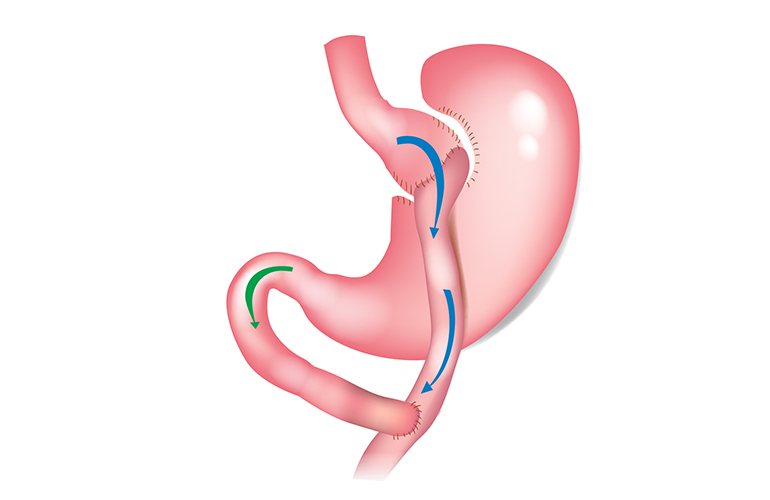
Gastric Bypass surgery is one of the most preferred surgical methods in bariatric surgery. It is both a restrictive and malabsorptive surgical method. With this surgery, while the stomach volume is reduced, an additional connection to the small intestine is made.
The part at the beginning of the stomach is separated from the rest with the help of special devices, leaving about 30-50 cc. While the stomach separated in sleeve gastrectomy is taken out of the body, the remaining large piece of stomach is left in the abdomen. Later, some of the small intestines are bypassed and connected to the newly formed small stomach.
This surgery can be performed with different surgical techniques such as Rouxen Y Gastric By-Pass (R-YGB) or single anastomosis Mini Gastric By-Pass. The junction of the stomach and intestine is determined according to the patient's weight and co-morbidities.
In this way, patients reach the feeling of fullness quickly with much smaller portions, and since the nutrients pass through a shorter absorption path, a decrease in their absorption occurs. As a result, effective and permanent weight loss is achieved with Laparoscopic Gastric By-Pass surgery. In addition, it provides effective long-term and sometimes permanent improvement in diseases such as hypertension and diabetes.
Similar to sleeve gastrectomy, patients should be followed up for element and vitamin deficiencies and the deficiencies should be replaced.
Gastric By-Pass surgeries are a more appropriate treatment method for patients with reflux findings that are not suitable for sleeve gastrectomy, those with binge eating, sugary eating addictions, or those with a higher body mass ratio.
What are the Gastric Bypass Types?
Roux en Y Gastric Bypass: In the operation, the stomach is divided into two parts with a special stapler device, leaving a stomach volume of approximately 25-30 cc from the area where the stomach meets the esophagus. This leaves a small stomach pouch and the other part of the stomach behind. Afterwards, the length of the small intestine is measured and the appropriate distance is determined for the patient, and then the intestine is separated and a connection is created between the small intestine and the small stomach sac with special devices.
The part of the intestine that brings the bile and pancreatic secretions and the secretions from the remaining stomach part is combined with the small intestine further from the gastrointestinal connection. Thus, the food coming from the esophagus passes into the intestine without passing through a large part of the stomach and meets with the bile and pancreatic secretion required for the absorption of nutrients in the future, thus bypassing the first part of the small intestine.
Mini-Gastric Bypass: In this procedure, a stomach sac slightly larger than the Roux en Y type is created using special laparoscopic stapler tools. Then, the small intestine is counted and the sufficient distance from the stomach exit is determined (usually about 200 cm) and the stomach is mouthed with the help of these devices. The most important difference from the Roux en Y type is that it does not require a second small intestine anastomosis as the small intestine is not completely separated from each other. Therefore, it is technically a little easier.
The weight loss mechanism is similar in both gastric bypass types.
Duodenal Switch
Duodenal switch operation is another method that may be suitable for patients with a very high body mass index, who need more weight loss goals, or who have uncontrolled diabetes. In this surgery, in addition to sleeve gastrectomy, the duodenum located at the end of the stomach is separated immediately after the stomach junction and the stomach side is mouthed to a forward segment of the small intestine. This process significantly reduces absorption. This procedure can be done with two mouthings, one between the intestines, as in Roux en Y gastric Bypass surgery, or with a single mouthing (SADS) as in Mini-gastric Bypass procedure.
Patients lose weight faster in a shorter time compared to the previously mentioned surgeries, but the main goal is blood sugar regulation quickly. In many patients, insulin use may be reduced or discontinued. It can be applied laparoscopically in today's conditions. In these patients, biochemistry, glucose, element and electrolyte values should be monitored in the postoperative period.
Biliopancreatic diversion surgery, which is a similar operation to this operation, is usually performed in two steps. Since the results of sleeve gastrectomy, which is applied as the first step operation, are extremely good, it has become a very rarely performed operation.

